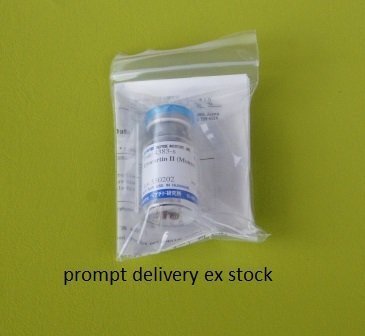Urocortin II (Mouse)
4383-s 0.1 mg | 106.00 EUR
Val – Ile – Leu – Ser – Leu – Asp – Val – Pro – Ile – Gly – Leu – Leu – Arg – Ile – Leu – Leu – Glu – Gln – Ala – Arg – Tyr – Lys – Ala – Ala – Arg – Asn – Gln – Ala – Ala – Thr – Asn – Ala – Gln – Ile – Leu – Ala – His – Val – NH2
| (M.W. 4152.9) | C187H320N56O50 |
Synthetic Product
The purity of Urocortin II is guaranteed to be higher than 99% by HPLC
Selective Ligand for Type 2 CRF Receptors
Urocortin II, a 38 amino acid residue peptide with an amidated C-terminus, was first predicted in mouse from a gene encoding a 112 amino acid residue [Proc. Natl. Acad. Sci. USA, 98, 2843 (2001)]. Simultaneously, human urocortin II (originally named as urocortin-related peptide) was postulated to be composed of the same 38 amino acid residues, although its carboxyl terminal extra-sequence is far from the common proteolytic processing signal, that is, Gly-His-Cys. Subsequently, a similar peptide, Stresscopin-Related Peptide (Human), was putatively identified in human, representing a 5 amino acid-extended urocortin II at the amino terminus.
Both chemically synthesized urocortin II/III and stresscopin / stresscopin-related peptide bind to and activate CRF-R2 (two isoforms, α and β ) selectively at nM concentrations or below. Actually, all the peptides stimulate the accumulation of cAMP through CRF-R2 but not CRF-R1. In addition, the ACTH releasing activity is not elicited by treatment with these peptides, indicating again the specific activation of CRF-R2. Additional activities involving the mediation of anorexic and vascular responses following stress are also attributed to these peptides:
- suppression of heat-induced edema which is associated with hypotensive effect of these peptides,
- feeding suppression in fasted mice,
- a suppressive role in gastric emptying activity, and so on.
Transcriptional and immunohistochemical analyses revealed that these peptides are expressed both centrally and peripherally with some differences in tissue distribution.
Huge experimental data concerning CRF-R1-mediated responses have already been accumulated using CRF. Therefore, adaptive responses to stress could be investigated more precisely and promptly using CRF-R2 specific ligands, stresscopin/urocortin family peptides.
References:
- T.M. Reyes, K. Lewis, M.H. Perrin, K.S. Kunitake, J. Vaughan, C.A. Arias, J.B. Hogenesch, J. Gulyas, J. Rivier, W.W. Vale and P.E. Sawchenko, Proc. Natl. Acad. Sci. USA, 98, 2843 (2001) (Urocortin II; Original)


